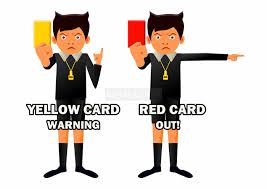The rules in soccer
SPORT
7/2/20255 min read


The Colorful Language of Discipline: Yellow and Red Cards in Soccer
Soccer, the world's most popular sport, is a game of passion, skill, and intense competition.1 But beneath the thrilling goals and intricate passes lies a crucial system of rules and regulations designed to ensure fair play, maintain player safety, and uphold the integrity of the game.2 Central to this system are the ubiquitous yellow and red cards, visual signals that have become an international language of discipline on the pitch.3 While they seem an inherent part of modern football, their introduction was a relatively recent innovation that dramatically changed how the game is officiated and perceived.
A Brief History: From Confusion to Clarity
Before the 1970 FIFA World Cup in Mexico, warnings and dismissals in soccer were communicated verbally by the referee, often leading to confusion, especially in international matches where language barriers were prevalent. A particularly contentious incident during the 1966 World Cup quarter-final between England and Argentina highlighted this problem. The German referee, Rudolf Kreitlein, sent off Argentine captain Antonio Rattín, who did not understand the decision and refused to leave the field, leading to a prolonged and chaotic stoppage.
This incident, witnessed by British referee Ken Aston, then a member of FIFA's Referee Committee, sparked a brilliant idea. Aston, while driving and observing a traffic light change from yellow to red, realized that universal color-coded cards could provide clear, unmistakable signals to players, coaches, and spectators alike.4 His concept was simple yet revolutionary: a yellow card for a caution and a red card for an expulsion. These cards were officially introduced at the 1970 World Cup and have since become an indispensable part of the beautiful game.5
The Yellow Card: A Cautionary Tale
The yellow card serves as a formal warning, indicating that a player has committed a foul or engaged in misconduct that violates the Laws of the Game but is not severe enough to warrant immediate dismissal.6 When a referee brandishes a yellow card, it's a clear message to the player that their conduct is being monitored, and further infractions will lead to more serious consequences.
A variety of offenses can lead to a yellow card, generally falling under the umbrella of "unsporting behavior" or actions that disrupt the flow and spirit of the game.7 Common reasons for a yellow card include:
Unsporting Behavior: This is a broad category that covers actions like feigning injury (diving/simulation), attempting to score with the hand (unless it results in a penalty kick and was not deliberate), or excessive celebration (e.g., removing a shirt).8
Dissent by Word or Action: Arguing with the referee's decisions, making disrespectful gestures, or verbally abusing opponents or officials.9
Persistent Infringement of the Laws: Repeatedly committing fouls, even minor ones, can lead to a yellow card as a cumulative warning.10
Delaying the Restart of Play: Wasting time by holding onto the ball, taking too long for a free-kick or throw-in, or preventing the opposing team from restarting the game quickly.11
Failure to Respect the Required Distance: Not standing the prescribed distance from an opponent's free kick, corner kick, or throw-in.
Entering, Re-entering, or Deliberately Leaving the Field of Play Without Permission: Players must seek the referee's approval before entering or leaving the playing area.
A player who receives a yellow card can continue to play, but their name and the offense are recorded by the referee. The crucial rule regarding yellow cards is that two yellow cards in the same match automatically result in a red card, leading to the player's immediate dismissal from the game.12
Beyond a single match, the accumulation of yellow cards can also lead to suspensions in various leagues and tournaments.13 While the specific number varies by competition (e.g., often five yellow cards in a season in leagues like the Premier League, La Liga, and MLS), reaching a certain threshold typically results in a one-match ban.14 These accumulated cards usually reset at the end of a season or at specific stages of a tournament (e.g., after the quarterfinals in some international competitions) to prevent players from missing crucial later matches due to minor infringements.15
The Red Card: Immediate Expulsion and Severe Consequences
The red card is the most severe disciplinary action a referee can take in soccer. When a red card is shown, the player is immediately sent off the field of play and cannot be replaced by a substitute. This leaves their team with one fewer player for the remainder of the match, a significant disadvantage that often forces a change in tactical approach, usually a more defensive posture.
Red cards are reserved for serious offenses that are deemed to be against the spirit of fair play, dangerous to other players, or a blatant attempt to undermine the game.16 The main reasons for a direct red card include:
Serious Foul Play: A tackle or challenge that endangers the safety of an opponent, such as a two-footed tackle, a reckless tackle from behind, or a challenge with excessive force.17
Violent Conduct: Acts of aggression, such as striking, kicking, or elbowing an opponent or any other person (teammate, official, spectator).18
Spitting at an Opponent or Any Other Person: A highly unsporting and unhygienic act that always results in a red card.
Denying an Obvious Goal-Scoring Opportunity (DOGSO): This can occur in two main ways:
By Handling the Ball: If a player (other than the goalkeeper within their penalty area) deliberately handles the ball to prevent a clear goal or goal-scoring opportunity.19
By a Foul: If a player commits a foul to prevent an opponent who has an obvious goal-scoring opportunity from scoring (e.g., a professional foul when they are the last defender).20
Using Offensive, Insulting, or Abusive Language and/or Gestures: Similar to dissent for a yellow card, but for more severe or sustained verbal or gestural abuse.
Receiving a Second Yellow Card: As mentioned, accumulating two yellow cards in the same match results in an automatic red card.21
The consequences of a red card extend beyond the immediate match. The dismissed player is typically suspended for at least the next game, with the length of the ban varying depending on the severity of the offense.22 Violent conduct, for instance, often leads to multi-game suspensions, and in some cases, disciplinary committees may impose additional fines or sanctions.23 Red card suspensions are generally not "wiped" at any point in a tournament or season and will carry over to subsequent matches until served.24
Impact on the Game
The yellow and red card system has a profound impact on the dynamics of a soccer match. A yellow card serves as an early warning, compelling players to adjust their behavior and play more cautiously to avoid a second booking.25 This often leads to a more disciplined approach, especially for players who are already on a yellow.
A red card, however, has an immediate and often decisive impact. Forcing a team to play with ten men for a significant portion of the game puts them at a severe disadvantage. This numerical disparity typically forces the shorthanded team to adopt a more defensive strategy, sacrificing attacking ambition to maintain defensive solidity. Conversely, the team with the numerical advantage can press higher, control possession more effectively, and create more scoring opportunities. Some of the most memorable and dramatic moments in soccer history have involved red cards, either through their influence on the outcome of a crucial match or the controversy surrounding their issuance.
In conclusion, the yellow and red card system, born from a need for clarity and universality, has become an indispensable element of modern soccer. These colorful pieces of plastic serve as a powerful visual language, enabling referees to effectively manage player conduct, ensure fair competition, and uphold the integrity of a sport loved by billions worldwide.26 They are a constant reminder that discipline and respect for the rules are as vital to the beautiful game as skill and strategy.
